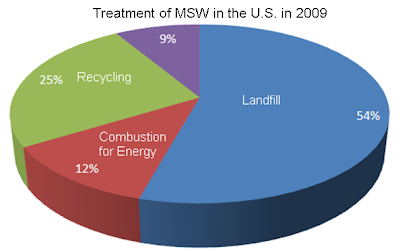 |
| Danehy Park is a 50-acre recreational site built on top of a landfill that was closed in the 1970s. |
 | ||
Source
Modern sanitary landfills are highly engineering systems that do not resemble the open dumps that people sometime imagine when landfills are mentioned. Open dumps still exist in many parts of the world. But, in the developed world such facilities are essentially non-existent. So, let's step through the landfill from bottom to top. Below the landfill we see an aquifer that we would like to keep contaminated leachate from reaching. The bottom layer of the landfill thus consists of a liner that typically consists of a couple feet of highly compacted clay and an impermeable geomembrane, which is essentially a plastic sheet that further inhibits leaks. Directly on top of the liner is the leachate collection layer which typically consists of a foot or so of gravel or some other hard, loose, material. The purpose of the leachate collection layer to provide the leachate an easy path to flow into the leachate collection system. Leachate is pumped out of the leachate collection system and then treated. Waste is piled on top of the leachate collection system. Each day the waste is covered, usually with soil, but other alternative daily covers exist. After all of the waste is in place, a final cover that consists of soil, clay, another geomembrane, top soil, and vegetation is put in place to inhibit water intrusion into the landfill. You'll also notice in both figures that there are pipes for methane/gas recovery. These pipes are either placed horizontally or vertically, and are used to collect the gas generated in the landfill. Landfill gas is typically 50% CO2 and 50% methane, with some other trace gases, but the composition changes with landfill age. The gas is either flared or combusted in a turbine or engine to generate heat and/or energy. Currently, over 500 landfills in the U.S. beneficially use their landfill gas, and another 500+ landfills are good candidates for such projects. Landfill gas is a renewable energy source that leads to significantly reduced emissions when compared to coal fired power. Another interesting environmental aspect of landfills is that landfills actually store carbon and can act as a carbon sink. Most organic materials will not completely degrade under anaerobic conditions (i.e., without oxygen), so significant quantities of carbon end up sequestered indefinitely in landfills. When a typical ton of MSW is buried in a landfill about 100 kg C (370 kg CO2e) end up indefinitely stored. Given enough time these organic deposits may develop into peat or lignite. This sequestration plus the generation of electricity means that a ton of MSW landfilled in a state-of-the-art landfills are actually carbon negative. For more information check out the How landfills work? article at HowStuffWorks.com or the EPA's landfill site. I think the next post on this topic will be on waste-to-energy combustion. Recycling was next in the original presentation, but it's a big topic to really cover properly, so I'll probably cover it last and in pieces. |











